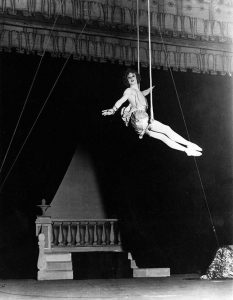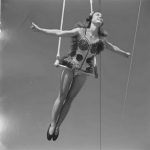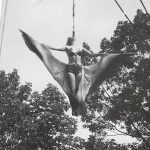In 1926, when 16-year-old Guy Oscar Blackburn crept out of Alabama City, Alabama, and joined the Christy Bros. travelling circus, his foremost thought was probably just to get out—to get away from small towns and small minds. Likely, he didn’t give much thought to what he might actually do with a travelling circus, but over the course of his subsequent 23-year circus career, he soared.
Literally.
He soared.
I have no idea what he did initially, but by 1928 he was a female impersonator and featured dancer, and by 1932, he was flying high on the single trapeze, swinging on swinging ladders and cloud swings, whirling above the big-top crowd on the iron jaw.
Dressed as a woman.

Like the internationally famous Vander Clyde, from Round Rock, Texas, performing throughout the United States and Europe in the 1920s and 30s as Barbette, the darling of Paris, adored by the likes of Jean Cocteau, photographed by the likes of Man Ray. Like Guy’s own female impersonator circus pals Frances Doran, Billie Dick, and Peggy/Karl Waddell (sometimes performing as “Georgette” but always living as “Peggy from Paris”). Like a good number of other 1930s circus aerialists and dancers.
Billed as “Peggy Blackburn.”
Cross-dressed and soaring.
Theatre and drama professor Peta Tait writes that circus “gender trickery” was common in aerial acts, which require a muscularity that always “blur[s] gender identity.” Crowds favored graceful, elegant feminine performers, yet marvelled at their strength to perform the daring swings and holds and catches. Tait explains: aerial acts require “a feminine look” but not “a female performer” (p. 66). She recounts, for instance, how, in 1923, Ringling-Barnum hired “dainty dancer” Berta Besson to perform “on the wire.” Though she “wore a softly feminine, calf-length dress with flounces and fluffs,” Berta was actually a female impersonator named Herbert.
International Circus Hall of Fame inductee John Milton Herriott explains circus “gender trickery” similarly. In a Bandwagon interview with Dale Riker, he recalls that the 1937 Barney Brothers Circus “had a female impersonator.” “[T]hat was a popular thing back in those days,” he notes, “and they would never tip their mitt, you know. They were in drag and them town suckers thought sure that was a woman, not like Barbette where he did his act and took the wig off” (Riker, p. 12). As a circus newbie auditioning for a vacancy in a 1912 aerial act, Vander Clyde was told that “women’s clothes always make a wire act more impressive.” To trick the rubes, Clyde was asked to dress as a girl and he became the great Barbette (“Barbette”). Later, his gender-blurring became a deliberate act of artistic expression, a deliberate complication of the very concept of gender : billing himself as a “man-woman,” he began his elaborate solo wire and trapeze performance as a woman, but, in a kind of aerial strip tease, he transformed into a man by act’s end (Tait, pp. 70-72).
The 1937 Barney Brothers performer whom John Herriott compares to the famous Barbette was Guy Oscar Blackburn, grandson of my great-grandmother’s brother: he is my second cousin once removed, and I know him only as a remote limb on my Ancestry.com family tree. He was born in 1910 in Alabama City, Alabama, and had a hard early life by all accounts. At age 16 he ran away and joined a passing circus. A family story posted by Guy’s grand-nephew Bill Blackburn on Ancestry.com probably explains the nature of Guy’s early hardship: he was “very femanin in features and would have past as a woman in real life.” On the 1940 census, Guy–though unemployed at the time– listed his occupation as “circus acrobat.”
John Herriott, who was only six years old in 1937, knew Guy, who was apparently memorable enough that Herriott spoke of him by name some sixty years later, revealing Guy to be not just a circus acrobat but one of those muscular gender-fluid high-flying aerialists. Herriott tells Riker, “We had [a female-impersonator] . . . named Guy Blackburn and he did a cloud swing and some other aerial act.” He also remembered Guy’s elaborately coiffed wigs, which Herriott’s mother styled for him, using young Herriott as her mannequin head when she marcelled them with hot curling tongs.

(Photo credit: Moicani-L’Odeonie, ” Flying Trapeze” blog post, 5 May 2013; moicani.over-blog.com/article-flying-trapeze-117146673.html/)
Wayne Keyser, in his “Circus Lingo Dictionary,” describes the cloud swing, mentioned by Herriott as one of Guy’s acts, as “a bar-less swing, really just a ‘u’ of rope.” The European Federation of Professional Circus Schools (or, FEDEC) offers more technical specifics: the cloud swing is a cloth-covered piece of inch-thick rope, about 27 feet long, the ends of which are affixed to two stationary points about 10-11 feet apart, high above the floor, allowing for a u-shaped drop about 12-13 feet deep. It is the modern aerial act most like the flying trapeze of yore (“Cloud Swing”).
Performers stand, sit, or hang from the U to form a V. From there, they do sitting swings, standing swings, swings while dangling from their knees or backs, even strenuous crucifix swings—all while maneuvering gracefully from skill to skill. The FEDEC notes that where a trapeze is “solid and weighted, the cloud swing is neither,” thus requiring more arm strength than the trapeze. It is also more dangerous because cloud swing performers rarely use safety nets (Keyser).
Extensive research in the archives of The Billboard reveals that Guy Blackburn’s other aerial acts were the single trapeze, the swinging ladders, and the iron jaw, on which he performed a “whirl of death.”

(Photo credit: Moicani-L’Odeonie, “Flying Trapeze” blog post, 5 May 2013; moicani.over-blog.com/article-flying-trapeze-117146673.html/)
The single trapeze, in the 1930s, was much the same as the single trap today. The apparatus is a bar attached to cloth-covered ropes, and it hangs from the rigging, high up in the circus tent. The act is called a single trap when there is only one aerialist performing alone (Rogers)—sometimes sitting, sometimes standing on the bar, sometimes hanging from the bar by the knees or ankles, sometimes balancing on the waist or hips. Sometimes stationary, sometimes swinging. Always moving gracefully from position to position. Always dancing on a bar high up in the air.
Guy also performed on the Swinging Ladders, which are exactly as billed: they are ladders strung up in the rigging, and they swing. Sometimes there is only one; sometimes there are several, swaying together in concert or oscillating in alternating patterns, all the while moving back and forth through the air. On them, aerialists do elaborate routines, balancing on the rungs, making demanding gymnastic stunts appear effortlessly sophisticated. On ladders. Swinging high above the crowds. (Rogers)

(photo credit: “Yankee Patterson Circus,” The Circus Blog, 17 Sep 2008; thecircusblog.wordpress.com)
The Iron Jaw is perhaps the most daunting of all of the aerial acts Guy executed. Sometimes called a “teeth act” or a “feat of dental equilibrium,” it involves gripping a bit between the teeth and being hoisted on a rope high up into the air. Some iron-jaw aerialists became human butterflies, fluttering about, caped arms moving like wings. Others might remain stark still, arms back and toes pointed, swinging in large circles above the crowds, suspended only by the teeth.
Or, iron-jaw performers might spin.
Guy’s “whirl of death” was a dangerous variation of an iron-jaw act, especially if it involved attaching an electric motor to the bit, as Guy’s contemporary, La Marletta, did in her own “whirl of death” act, achieving a motorized spin of up to 500 revolutions per minute, hanging anywhere from 70 to 100 feet in the air (“Ringling-Barnum Notes”).

Guy may or may not have used a motor in his “Whirl of Death,” but an iron-jaw aerialist could achieve a decent spin by using only the natural momentum of a twisted rope. Guy’s highest spin appears to have been done from 42 feet in the air. It was also his longest fall.
In 1938 he broke his arm and likely never spun again.
Still, despite the danger, how wonderful it must have been for an alienated effeminate Alabama mill-town boy to create a home for himself among the hard-working but welcoming tribe of American circus folk. How comforting to find a safe place to live, with plenty of food to eat. How adventurous to be paid to travel the country in the middle of the Great Depression.
How thrilling–thrilling–to soar.
Works Cited
“Barbette.” Wikipedia. Accessed on 16 Jan. 2019.
Blackburn, Bill. “Employment of Guy O. Blackburn.” Posted 14 Aug. 2007. Memo on Ancestry.com. Accessed 1 Jun. 2018.
“Cloud Swing.” Wikipedia. Accessed on 21 Feb. 2019.
European Federation of Professional Circus Schools (FEDEC). “Part 2 – Cloud Swing.” In “Manual for Swinging Trapeze and Cloud Swing.“ http://www.fedec.eu/en/articles/413-swinging-trapeze-and-cloud-swing . Accessed 25 Feb. 2019.
“Iron Jaw.” Wikipedia. Accessed on 15 Apr. 2019.
Keyser, Wayne. “Cloud Swing” in “Circus Lingo Dictionary.” BallyCast. Ballycast.com. Accessed 25 Feb. 2019.
Riker, Dale. “An Interview with John Herriott.” Bandwagon. 54:4 (Jul. 2010): pp. 4-21.
“Ringling-Barnum Notes.” The Billboard. 30 Apr. 1927, p. 74.
Rogers, Joseph W. Circus Aerial Acts. Education Committee of the Circus Fans Association of America. 1996. Reprint on www.circusfans.org. Last updated, 18 May 2006.
Tait, Peta. “Chapter 3: Cross-dressing and Female Muscular Drag,” Circus Bodies: Cultural Identity in Aerial Performance. Routledge, 2005. Pp. 66-89.
“Trapeze.” Wikipedia. Accessed on 15 Apr. 2019.